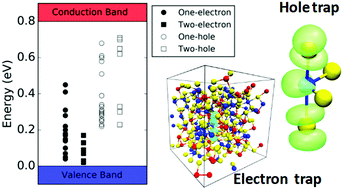Inherent electron and hole trapping in amorphous phase-change memory materials: Ge2Sb2Te5
Abstract
While the amorphous state of a chalcogenide phase-change material is formed inside an electronic-memory device via Joule heating, caused by an applied voltage pulse, it is in the presence of excess field-induced electrons and holes. Here, hybrid density-functional-theory calculations for glassy Ge2Sb2Te5 demonstrate that extra electrons are trapped spontaneously, creating deep traps in the band gap. Hole self-trapping is also energetically favourable, producing states around midgap. The traps have a relatively low ionization energy, indicating that they can easily be thermally released. Near-linear triatomic Te–Ge/Sb–Te/Ge/Sb environments are the structural motifs where the extra electrons/holes are trapped inside the glass network, highlighting that the intrinsic axial bonds of octahedral-like sites in amorphous Ge2Sb2Te5 can serve as charge-trapping centres. Trapping of two electrons in a chain-like structure of connected triads results in breaking of some of these highly polarizable long bonds. These results establish the foundations of the origin of charge trapping in amorphous phase-change materials, and they may have important implications for our understanding of resistance drift in electronic-memory devices and of electronic-excitation-induced athermal melting.



 Please wait while we load your content...
Please wait while we load your content...